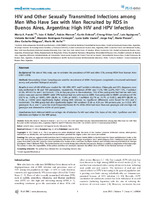Use este identificador para citar ou linkar para este item:
http://sgc.anlis.gob.ar/handle/123456789/401| Título: | HIV and other sexually transmitted infections among men who have sex with men recruited by RDS in Buenos Aires, Argentina : high HIV and HPV Infection | Autor(es): | Pando, María A. Balán, Iván C. Marone, Rubén Dolezal, Curtis Leu, Cheng-Shiun Squiquera, Luis Barreda, Victoria Rodriguez Fermepín, Marcelo Gallo Vaulet, Lucia Rey, Jorge Picconi, María Alejandra Carballo Dieguez, Alex Avila, María M. |
Palavras-chave: | VIH;Enfermedades de Transmisión Sexual;Virus de la Hepatitis B;Argentina;Buenos Aires | Data do documento: | 2012 | Descrição: | BACKGROUND The aim of this study was to estimate the prevalence of HIV and other STIs, among MSM from Buenos Aires (2007-2009). METHODS Responding Driven Sampling was used for recruitment of MSM. Participants completed a structured web-based survey and provided biological samples. RESULTS A total of 496 MSM were studied for HIV, HBV, HCV, and T pallidum infections. Chlamydia and HPV diagnoses were only performed in 98 and 109 participants, respectively. Prevalence of HIV was 17.3%, HBV 22.9%, HCV 7.5%, T pallidum 20.5%, HPV 83.5%, and C trachomatis 1.7%. In the year prior to the evaluation, 71% of the participants had had sex with men and/or trans and women (MMW) while 29% had not had sex with women (MM). Comparing MM to MMW, prevalence of HIV (30.7% vs. 11.9%, p<0.001), HBV (36.4% vs. 17.8%, p<0.001), T pallidum (32.1% vs. 15.7%, p<0.001), and HPV (88.3% vs. 70.4%, p = 0.039) were significantly higher among MM, whereas no significant differences were found for HCV and C trachomatis. The MM group had also significantly higher HIV incidence (5.60 vs. 4.28 per 100 persons-year, p = 0.032). HPV genotypes 16, 6, and 11 were the most frequently found; 40.7% of the MSM had more than one genotype and one high risk genotype was detected in 43.6% of participants. CONCLUSIONS Both MM and MMW are at high risk of infection for HIV and other STIs. Rates of HIV, HBV, T pallidum and HPV infections are higher in the MM group. Fil: Pando, María A. Universidad de Buenos Aires. Instituto de Investigaciones Biomédicas en Retrovirus y SIDA (INBIRS); Argentina. Fil: Balán, Iván C. New York State Psychiatric Institute. HIV Center for Clinical and Behavioral Studies; Estados Unidos. Fil: Dolezal, Curtis. New York State Psychiatric Institute. HIV Center for Clinical and Behavioral Studies; Estados Unidos. Fil: Marone, Rubén. Nexo Asociación Civil; Argentina. Fil: Leu, Cheng-Shiun. New York State Psychiatric Institute. HIV Center for Clinical and Behavioral Studies; Estados Unidos. Fil: Squiquera, Luis. Nexo Asociación Civil; Argentina. Fil: Barreda, Victoria. Nexo Asociación Civil; Argentina. Fil: Rodriguez Fermepín, Marcelo. Universidad de Buenos Aires. Inmunología Clínica; Argentina. Fil: Gallo Vaulet, Lucia. Universidad de Buenos Aires. Inmunología Clínica; Argentina. Fil: Rey, Jorge. Universidad de Buenos Aires. División de Enfermedades de Transmisión Transfusional Fil: Picconi, María Alejandra. ANLIS Dr.C.G.Malbrán. Instituto Nacional de Enfermedades Infecciosas. Laboratorio Nacional de Referencia de Papilomavirus (HPV); Argentina. Fil: Carballo Dieguez, Alex. New York State Psychiatric Institute. HIV Center for Clinical and Behavioral Studies; Estados Unidos. Fil: Avila, María M. Universidad de Buenos Aires. Instituto de Investigaciones Biomédicas en Retrovirus y SIDA (INBIRS); Argentina. |
URI: | http://sgc.anlis.gob.ar/handle/123456789/401 http://www.plosone.org/article/info%3Adoi%2F10.1371%2Fjournal.pone.0039834 |
ISSN: | 1932-6203 | Direitos: | info:eu-repo/semantics/openAccess |
| Aparece nas Coleções: | snrd Publicaciones INEI |
Arquivos neste item:
| Arquivo | Descrição | Tamanho | Formato | |
|---|---|---|---|---|
| PloSOne,2012,7(6),e39834.pdf | 498.3 kB | Adobe PDF |  Ver/Aberto |
Visualização de página
142
Checado em 16/12/2025
Download(s)
101
Checado em 16/12/2025
Google ScholarTM
Checar
Os itens no repositório estão protegidos por copyright, com todos os direitos reservados, salvo quando é indicado o contrário.

